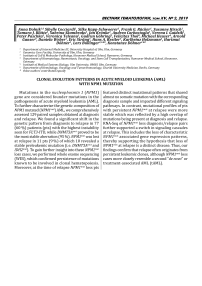Clonal evolution patterns in acute myeloid leukemia (AML)with npm1 mutation
Автор: Dolnik Anna, Cocciardi Sibylle, Kapp-Schwoerer Silke, Rucker Frank G., Hirsch Susanne, Blatte Tamara J., Skambraks Sabrina, Kronke Jan, Corbacioglu Andrea, Gaidzik Verena I., Paschka Peter, Teleanu Veronica, Gohring Gudrun, Thol Felicitas, Heuser Michael, Ganser Arnold, Weber Daniela, Strang Eric, Kestler Hans A., Holzmann Karlheinz, Dehne Hartmut, Bullinger Lars, Dohner Konstanze
Журнал: Вестник гематологии @bulletin-of-hematology
Статья в выпуске: 2 т.15, 2019 года.
Бесплатный доступ
Короткий адрес: https://sciup.org/170171693
IDR: 170171693
Текст статьи Clonal evolution patterns in acute myeloid leukemia (AML)with npm1 mutation
Anna Dolnik1,6 Sibylle Cocciardi1, Silke Kapp-Schwoerer1, Frank G. Rücker1, Susanne Hirsch1, Tamara J. Blätte1, Sabrina Skambraks1, Jan Krönke1, Andrea Corbacioglu1, Verena I. Gaidzik1, Peter Paschka1, Veronica Teleanu1, Gudrun Göhring3, Felicitas Thol4, Michael Heuser4, Arnold Ganser4, Daniela Weber1, Eric Sträng5, Hans A. Kestler5, Karlheinz Holzmann2, Hartmut Döhner1, Lars Bullinger1,6*#, Konstanze Döhner1*#
-
1 Department of Internal Medicine III, University Hospital of Ulm, Ulm, Germany
-
2 Genomics Core Facility, University of Ulm, Ulm, Germany
-
3 Institute of Cell & Molecular Pathology, Hannover Medical School, Hannover, Germany
-
4 Department of Haematology, Haemostasis, Oncology, and Stem Cell Transplantation, Hannover Medical School, Hannover, Germany
-
5 Institute of Medical Systems Biology, Ulm University, 89081 Ulm, Germany
-
6 Department of Hematology, Oncology and Tumorimmunology, Charité University Medicine, Berlin, Germany
* these authors contributed equally
CLONAL EVOLUTION PATTERNS IN ACUTE MYELOID LEUKEMIA ^AML^ WITH NPM1 MUTATION
Mutations in the nucleophosmin 1 (NPM1) gene are considered founder mutations in the pathogenesis of acute myeloid leukemia (AML). To further characterize the genetic composition of NPM1 mutated (NPM1mut) AML, we comprehensively assessed 129paired samples obtained at diagnosis and relapse. We found a significant shift in the genetic pattern from diagnosis to relapse in 77 (60 %) patients (pts) with the highest instability seen for FLT3-ITD, while DNMT3Amut proved to be the most stable aberration (95 %). NPM1mut was lost at relapse in 11 pts (9 %) of which 10 revealed a stable preleukemic mutation (i. e. DNMT3Amut and IDH2mut). To gain further insight into these NPM1mut loss cases, we performed whole exome sequencing (WES), which confirmed persistence of mutations known to be involved in clonal hematopoiesis. Moreover, at the time of relapse NPM1mut loss pts featured distinct mutational patterns that shared almost no somatic mutation with the corresponding diagnosis sample and impacted different signaling pathways. In contrast, mutational profiles of pts with persistent NPM1mut at relapse were more stable which was reflected by a high overlap of mutations being present at diagnosis and relapse. RNA-Seq of NPM1mut loss diagnosis/relapse pairs further supported a switch in signaling cascades at relapse. This includes the loss of characteristic NPM1mut associated gene expression patterns, thereby supporting the hypothesis that loss of NPM1mut at relapse is a distinct disease. Thus, our findings confirm that relapse often originates from persistent leukemic clones, although NPM1mut loss cases more closely resemble a second “de novo” or treatment-associated AML (tAML).


